HA2032 Financial Analysis: Wesfarmers and Woolworth Report
VerifiedAdded on 2022/09/16
|21
|4292
|10
Report
AI Summary
This report provides a detailed financial analysis of Wesfarmers and Woolworth, two prominent ASX-listed companies. The analysis begins with an examination of owner's equity, including issued share capital, reserved shares, retained earnings, and reserves, providing insights into each component's characteristics and impact on the companies' financial positions. The report then delves into the liabilities of both companies, categorizing them into current and non-current liabilities and explaining key items like trade payables and interest-bearing loans. Furthermore, the report explores the advantages and disadvantages of debt and equity financing methods, offering a comparative analysis. Finally, it discusses the various compliance and reporting requirements for small companies, large proprietary companies, and reporting entities, providing a comprehensive overview of financial reporting standards and practices.
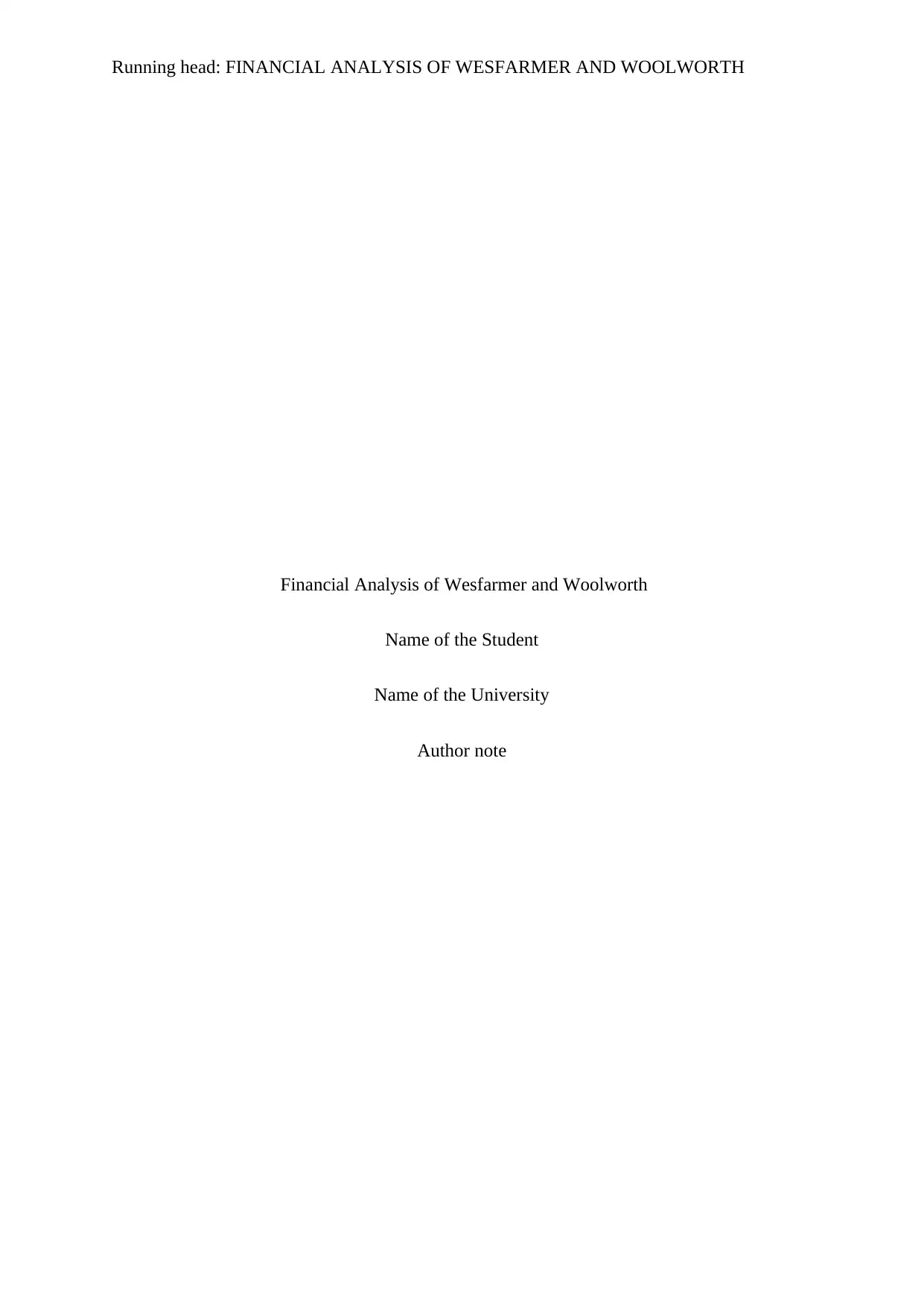
Running head: FINANCIAL ANALYSIS OF WESFARMER AND WOOLWORTH
Financial Analysis of Wesfarmer and Woolworth
Name of the Student
Name of the University
Author note
Financial Analysis of Wesfarmer and Woolworth
Name of the Student
Name of the University
Author note
Paraphrase This Document
Need a fresh take? Get an instant paraphrase of this document with our AI Paraphraser
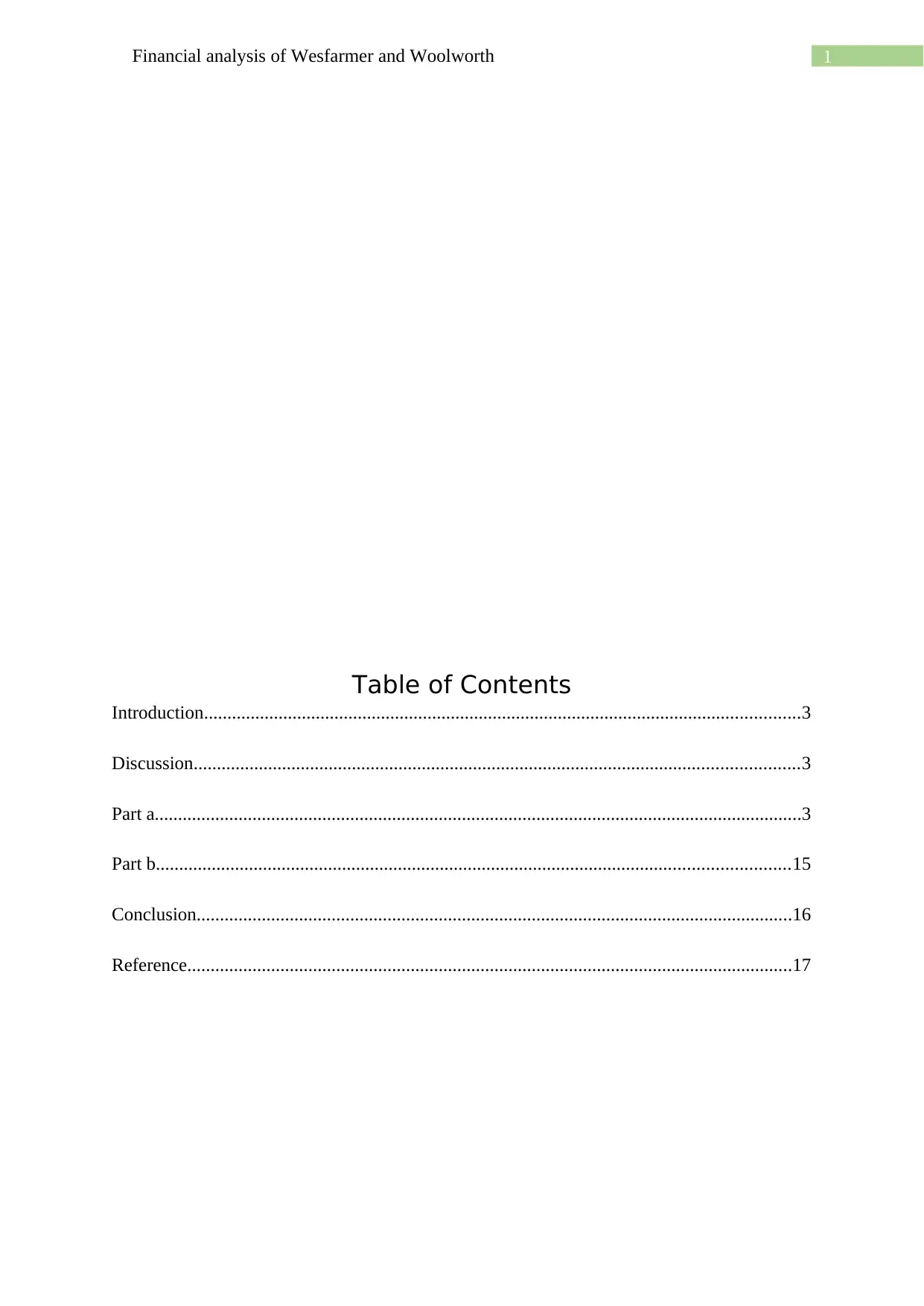
1Financial analysis of Wesfarmer and Woolworth
Table of Contents
Introduction................................................................................................................................3
Discussion..................................................................................................................................3
Part a...........................................................................................................................................3
Part b........................................................................................................................................15
Conclusion................................................................................................................................16
Reference..................................................................................................................................17
Table of Contents
Introduction................................................................................................................................3
Discussion..................................................................................................................................3
Part a...........................................................................................................................................3
Part b........................................................................................................................................15
Conclusion................................................................................................................................16
Reference..................................................................................................................................17
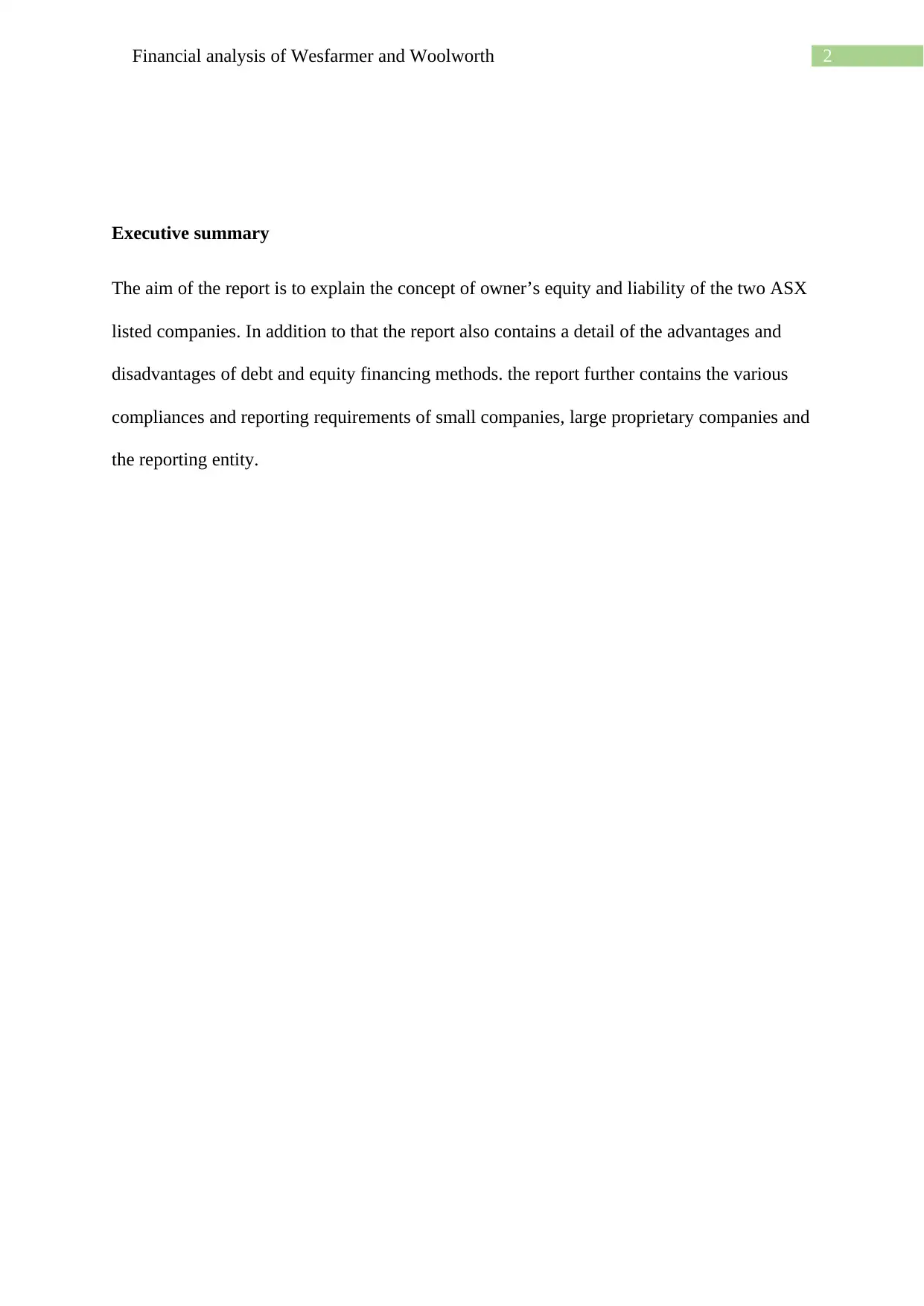
2Financial analysis of Wesfarmer and Woolworth
Executive summary
The aim of the report is to explain the concept of owner’s equity and liability of the two ASX
listed companies. In addition to that the report also contains a detail of the advantages and
disadvantages of debt and equity financing methods. the report further contains the various
compliances and reporting requirements of small companies, large proprietary companies and
the reporting entity.
Executive summary
The aim of the report is to explain the concept of owner’s equity and liability of the two ASX
listed companies. In addition to that the report also contains a detail of the advantages and
disadvantages of debt and equity financing methods. the report further contains the various
compliances and reporting requirements of small companies, large proprietary companies and
the reporting entity.
⊘ This is a preview!⊘
Do you want full access?
Subscribe today to unlock all pages.

Trusted by 1+ million students worldwide
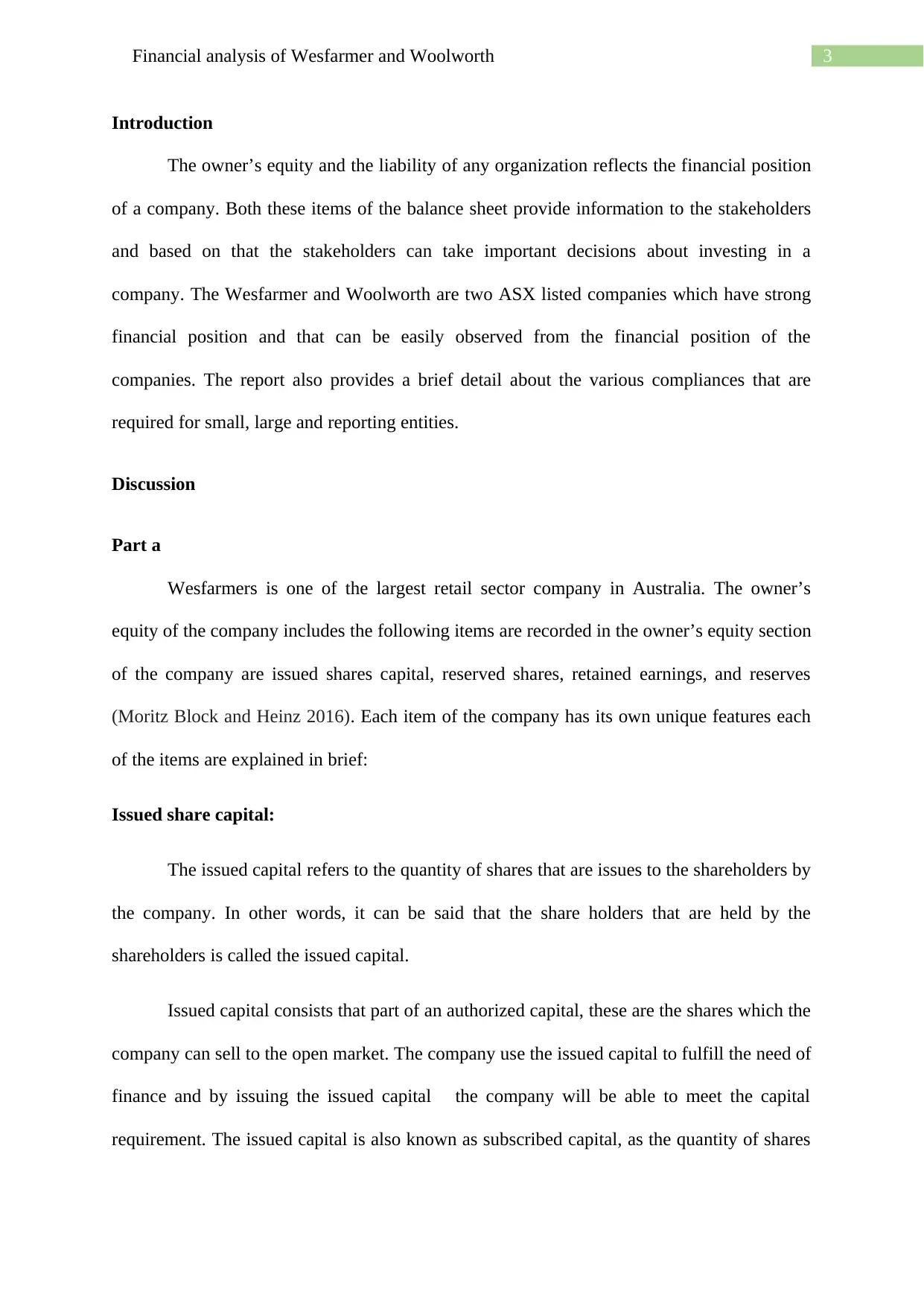
3Financial analysis of Wesfarmer and Woolworth
Introduction
The owner’s equity and the liability of any organization reflects the financial position
of a company. Both these items of the balance sheet provide information to the stakeholders
and based on that the stakeholders can take important decisions about investing in a
company. The Wesfarmer and Woolworth are two ASX listed companies which have strong
financial position and that can be easily observed from the financial position of the
companies. The report also provides a brief detail about the various compliances that are
required for small, large and reporting entities.
Discussion
Part a
Wesfarmers is one of the largest retail sector company in Australia. The owner’s
equity of the company includes the following items are recorded in the owner’s equity section
of the company are issued shares capital, reserved shares, retained earnings, and reserves
(Moritz Block and Heinz 2016). Each item of the company has its own unique features each
of the items are explained in brief:
Issued share capital:
The issued capital refers to the quantity of shares that are issues to the shareholders by
the company. In other words, it can be said that the share holders that are held by the
shareholders is called the issued capital.
Issued capital consists that part of an authorized capital, these are the shares which the
company can sell to the open market. The company use the issued capital to fulfill the need of
finance and by issuing the issued capital the company will be able to meet the capital
requirement. The issued capital is also known as subscribed capital, as the quantity of shares
Introduction
The owner’s equity and the liability of any organization reflects the financial position
of a company. Both these items of the balance sheet provide information to the stakeholders
and based on that the stakeholders can take important decisions about investing in a
company. The Wesfarmer and Woolworth are two ASX listed companies which have strong
financial position and that can be easily observed from the financial position of the
companies. The report also provides a brief detail about the various compliances that are
required for small, large and reporting entities.
Discussion
Part a
Wesfarmers is one of the largest retail sector company in Australia. The owner’s
equity of the company includes the following items are recorded in the owner’s equity section
of the company are issued shares capital, reserved shares, retained earnings, and reserves
(Moritz Block and Heinz 2016). Each item of the company has its own unique features each
of the items are explained in brief:
Issued share capital:
The issued capital refers to the quantity of shares that are issues to the shareholders by
the company. In other words, it can be said that the share holders that are held by the
shareholders is called the issued capital.
Issued capital consists that part of an authorized capital, these are the shares which the
company can sell to the open market. The company use the issued capital to fulfill the need of
finance and by issuing the issued capital the company will be able to meet the capital
requirement. The issued capital is also known as subscribed capital, as the quantity of shares
Paraphrase This Document
Need a fresh take? Get an instant paraphrase of this document with our AI Paraphraser
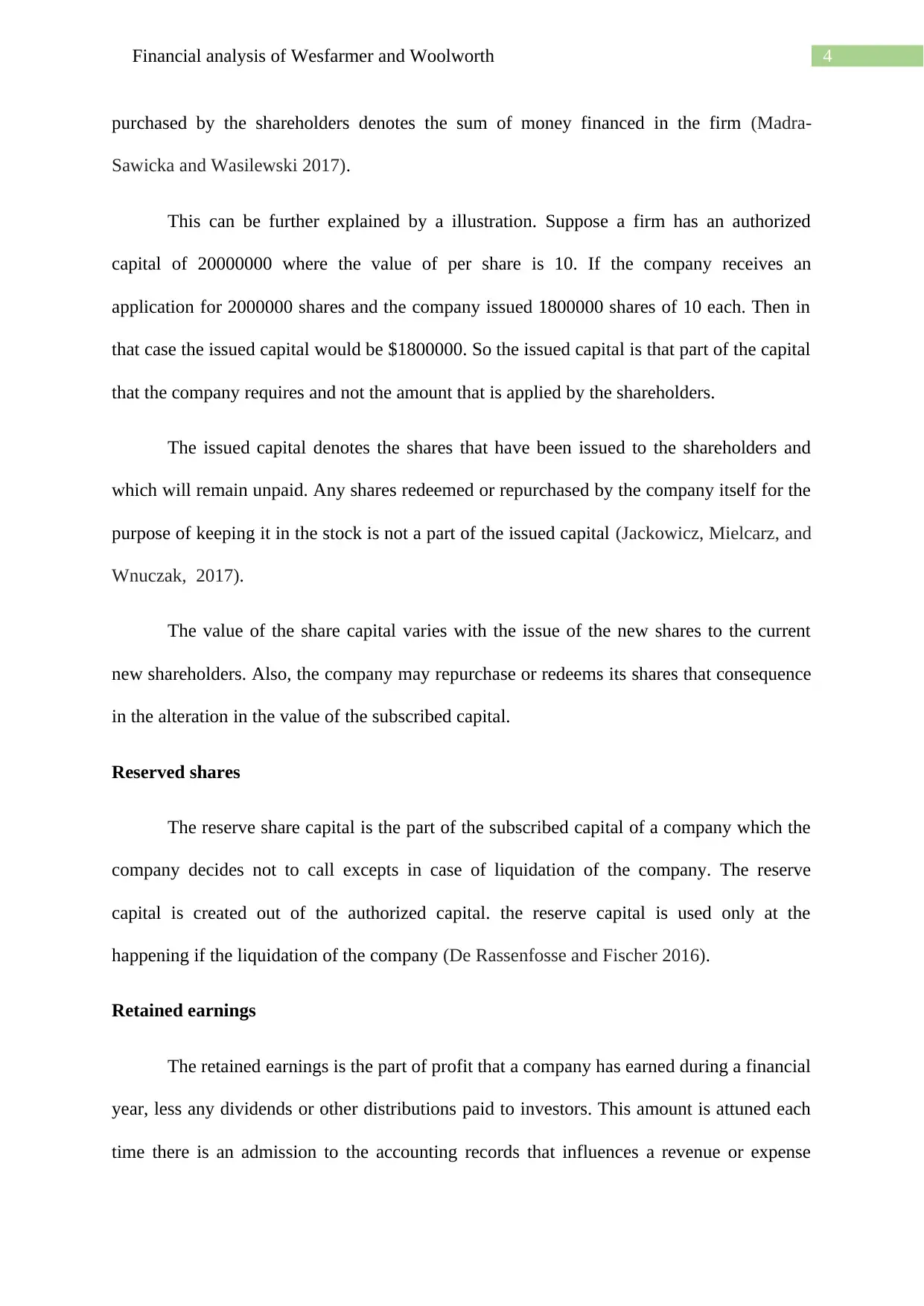
4Financial analysis of Wesfarmer and Woolworth
purchased by the shareholders denotes the sum of money financed in the firm (Madra-
Sawicka and Wasilewski 2017).
This can be further explained by a illustration. Suppose a firm has an authorized
capital of 20000000 where the value of per share is 10. If the company receives an
application for 2000000 shares and the company issued 1800000 shares of 10 each. Then in
that case the issued capital would be $1800000. So the issued capital is that part of the capital
that the company requires and not the amount that is applied by the shareholders.
The issued capital denotes the shares that have been issued to the shareholders and
which will remain unpaid. Any shares redeemed or repurchased by the company itself for the
purpose of keeping it in the stock is not a part of the issued capital (Jackowicz, Mielcarz, and
Wnuczak, 2017).
The value of the share capital varies with the issue of the new shares to the current
new shareholders. Also, the company may repurchase or redeems its shares that consequence
in the alteration in the value of the subscribed capital.
Reserved shares
The reserve share capital is the part of the subscribed capital of a company which the
company decides not to call excepts in case of liquidation of the company. The reserve
capital is created out of the authorized capital. the reserve capital is used only at the
happening if the liquidation of the company (De Rassenfosse and Fischer 2016).
Retained earnings
The retained earnings is the part of profit that a company has earned during a financial
year, less any dividends or other distributions paid to investors. This amount is attuned each
time there is an admission to the accounting records that influences a revenue or expense
purchased by the shareholders denotes the sum of money financed in the firm (Madra-
Sawicka and Wasilewski 2017).
This can be further explained by a illustration. Suppose a firm has an authorized
capital of 20000000 where the value of per share is 10. If the company receives an
application for 2000000 shares and the company issued 1800000 shares of 10 each. Then in
that case the issued capital would be $1800000. So the issued capital is that part of the capital
that the company requires and not the amount that is applied by the shareholders.
The issued capital denotes the shares that have been issued to the shareholders and
which will remain unpaid. Any shares redeemed or repurchased by the company itself for the
purpose of keeping it in the stock is not a part of the issued capital (Jackowicz, Mielcarz, and
Wnuczak, 2017).
The value of the share capital varies with the issue of the new shares to the current
new shareholders. Also, the company may repurchase or redeems its shares that consequence
in the alteration in the value of the subscribed capital.
Reserved shares
The reserve share capital is the part of the subscribed capital of a company which the
company decides not to call excepts in case of liquidation of the company. The reserve
capital is created out of the authorized capital. the reserve capital is used only at the
happening if the liquidation of the company (De Rassenfosse and Fischer 2016).
Retained earnings
The retained earnings is the part of profit that a company has earned during a financial
year, less any dividends or other distributions paid to investors. This amount is attuned each
time there is an admission to the accounting records that influences a revenue or expense
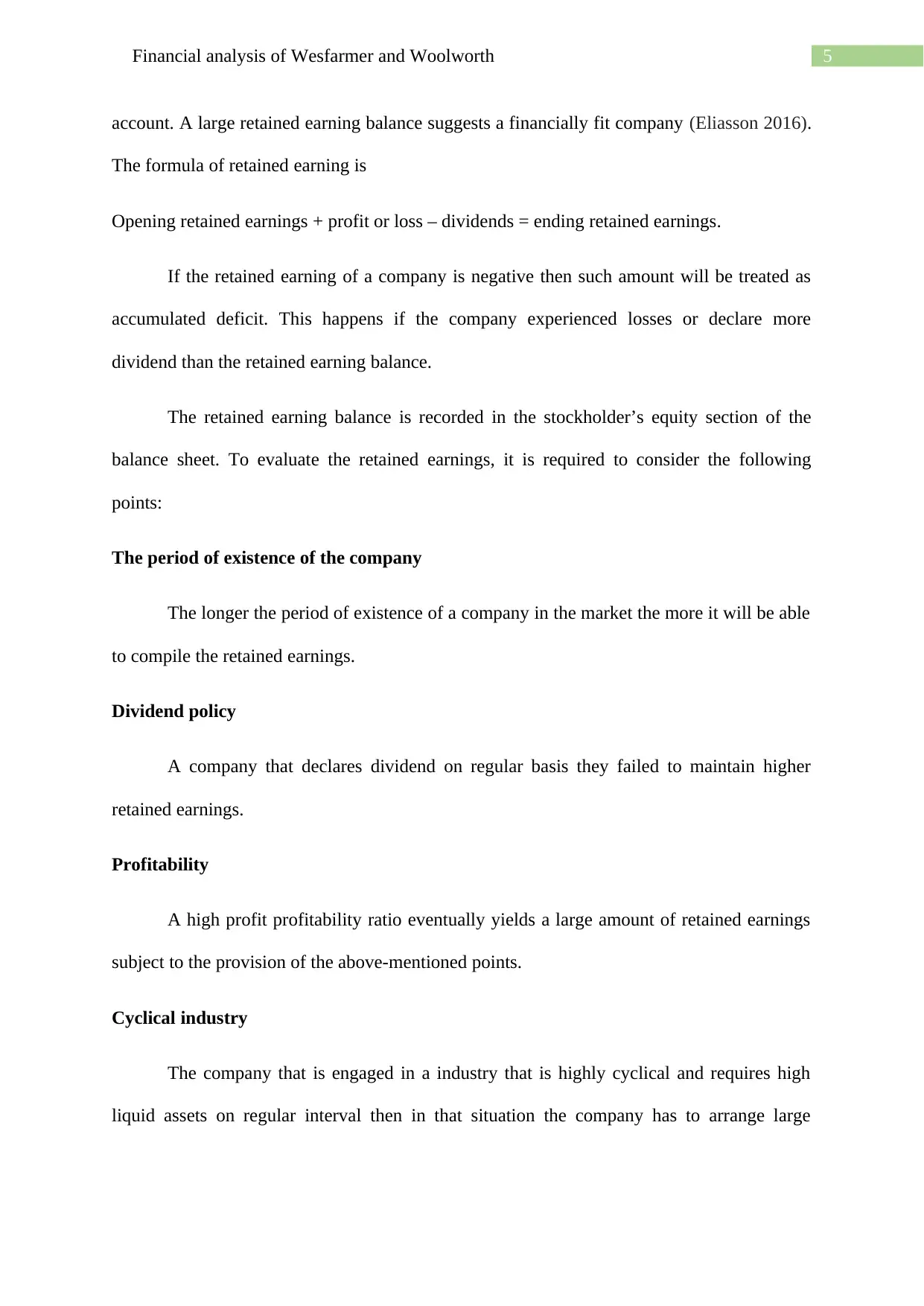
5Financial analysis of Wesfarmer and Woolworth
account. A large retained earning balance suggests a financially fit company (Eliasson 2016).
The formula of retained earning is
Opening retained earnings + profit or loss – dividends = ending retained earnings.
If the retained earning of a company is negative then such amount will be treated as
accumulated deficit. This happens if the company experienced losses or declare more
dividend than the retained earning balance.
The retained earning balance is recorded in the stockholder’s equity section of the
balance sheet. To evaluate the retained earnings, it is required to consider the following
points:
The period of existence of the company
The longer the period of existence of a company in the market the more it will be able
to compile the retained earnings.
Dividend policy
A company that declares dividend on regular basis they failed to maintain higher
retained earnings.
Profitability
A high profit profitability ratio eventually yields a large amount of retained earnings
subject to the provision of the above-mentioned points.
Cyclical industry
The company that is engaged in a industry that is highly cyclical and requires high
liquid assets on regular interval then in that situation the company has to arrange large
account. A large retained earning balance suggests a financially fit company (Eliasson 2016).
The formula of retained earning is
Opening retained earnings + profit or loss – dividends = ending retained earnings.
If the retained earning of a company is negative then such amount will be treated as
accumulated deficit. This happens if the company experienced losses or declare more
dividend than the retained earning balance.
The retained earning balance is recorded in the stockholder’s equity section of the
balance sheet. To evaluate the retained earnings, it is required to consider the following
points:
The period of existence of the company
The longer the period of existence of a company in the market the more it will be able
to compile the retained earnings.
Dividend policy
A company that declares dividend on regular basis they failed to maintain higher
retained earnings.
Profitability
A high profit profitability ratio eventually yields a large amount of retained earnings
subject to the provision of the above-mentioned points.
Cyclical industry
The company that is engaged in a industry that is highly cyclical and requires high
liquid assets on regular interval then in that situation the company has to arrange large
⊘ This is a preview!⊘
Do you want full access?
Subscribe today to unlock all pages.

Trusted by 1+ million students worldwide
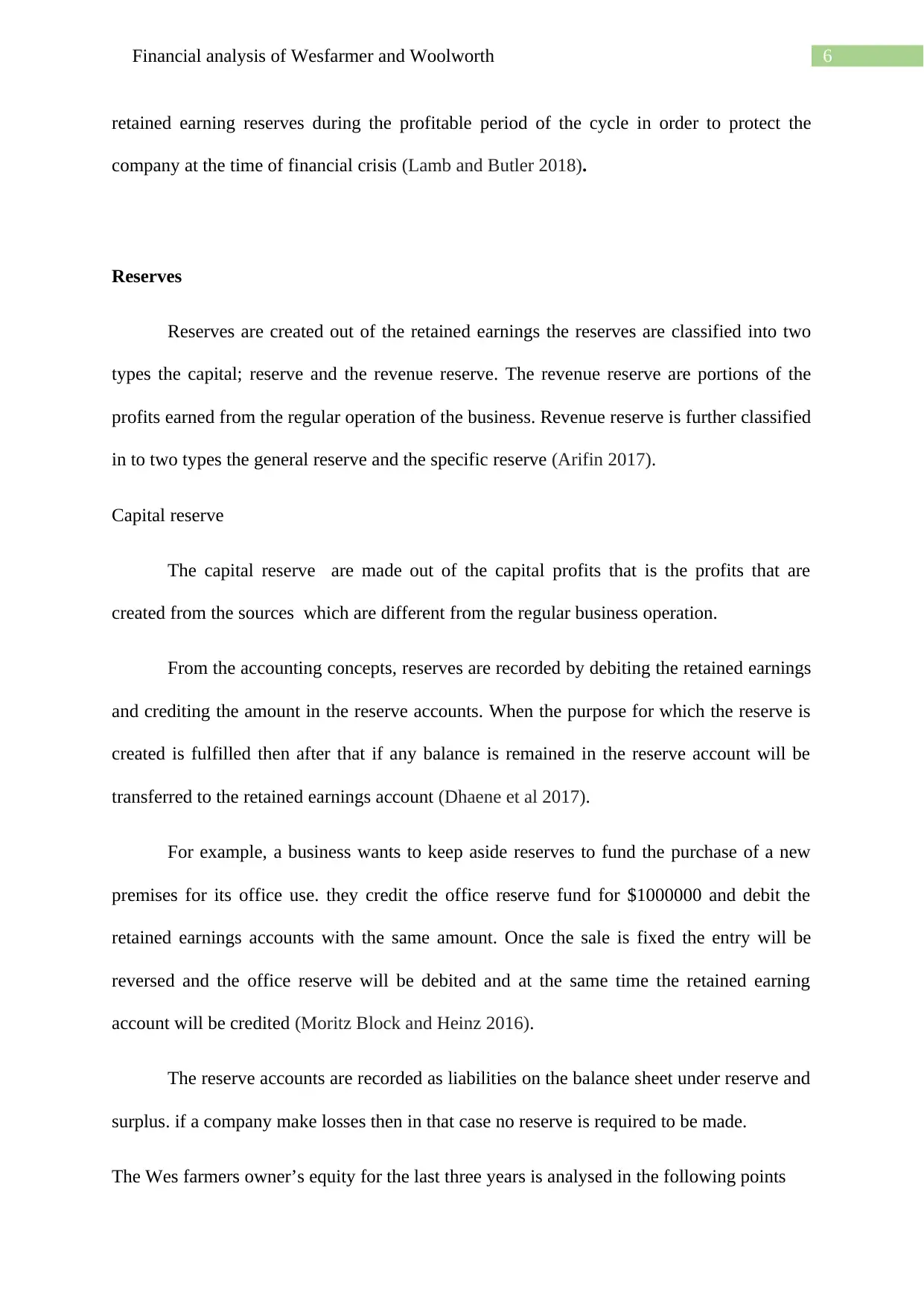
6Financial analysis of Wesfarmer and Woolworth
retained earning reserves during the profitable period of the cycle in order to protect the
company at the time of financial crisis (Lamb and Butler 2018).
Reserves
Reserves are created out of the retained earnings the reserves are classified into two
types the capital; reserve and the revenue reserve. The revenue reserve are portions of the
profits earned from the regular operation of the business. Revenue reserve is further classified
in to two types the general reserve and the specific reserve (Arifin 2017).
Capital reserve
The capital reserve are made out of the capital profits that is the profits that are
created from the sources which are different from the regular business operation.
From the accounting concepts, reserves are recorded by debiting the retained earnings
and crediting the amount in the reserve accounts. When the purpose for which the reserve is
created is fulfilled then after that if any balance is remained in the reserve account will be
transferred to the retained earnings account (Dhaene et al 2017).
For example, a business wants to keep aside reserves to fund the purchase of a new
premises for its office use. they credit the office reserve fund for $1000000 and debit the
retained earnings accounts with the same amount. Once the sale is fixed the entry will be
reversed and the office reserve will be debited and at the same time the retained earning
account will be credited (Moritz Block and Heinz 2016).
The reserve accounts are recorded as liabilities on the balance sheet under reserve and
surplus. if a company make losses then in that case no reserve is required to be made.
The Wes farmers owner’s equity for the last three years is analysed in the following points
retained earning reserves during the profitable period of the cycle in order to protect the
company at the time of financial crisis (Lamb and Butler 2018).
Reserves
Reserves are created out of the retained earnings the reserves are classified into two
types the capital; reserve and the revenue reserve. The revenue reserve are portions of the
profits earned from the regular operation of the business. Revenue reserve is further classified
in to two types the general reserve and the specific reserve (Arifin 2017).
Capital reserve
The capital reserve are made out of the capital profits that is the profits that are
created from the sources which are different from the regular business operation.
From the accounting concepts, reserves are recorded by debiting the retained earnings
and crediting the amount in the reserve accounts. When the purpose for which the reserve is
created is fulfilled then after that if any balance is remained in the reserve account will be
transferred to the retained earnings account (Dhaene et al 2017).
For example, a business wants to keep aside reserves to fund the purchase of a new
premises for its office use. they credit the office reserve fund for $1000000 and debit the
retained earnings accounts with the same amount. Once the sale is fixed the entry will be
reversed and the office reserve will be debited and at the same time the retained earning
account will be credited (Moritz Block and Heinz 2016).
The reserve accounts are recorded as liabilities on the balance sheet under reserve and
surplus. if a company make losses then in that case no reserve is required to be made.
The Wes farmers owner’s equity for the last three years is analysed in the following points
Paraphrase This Document
Need a fresh take? Get an instant paraphrase of this document with our AI Paraphraser
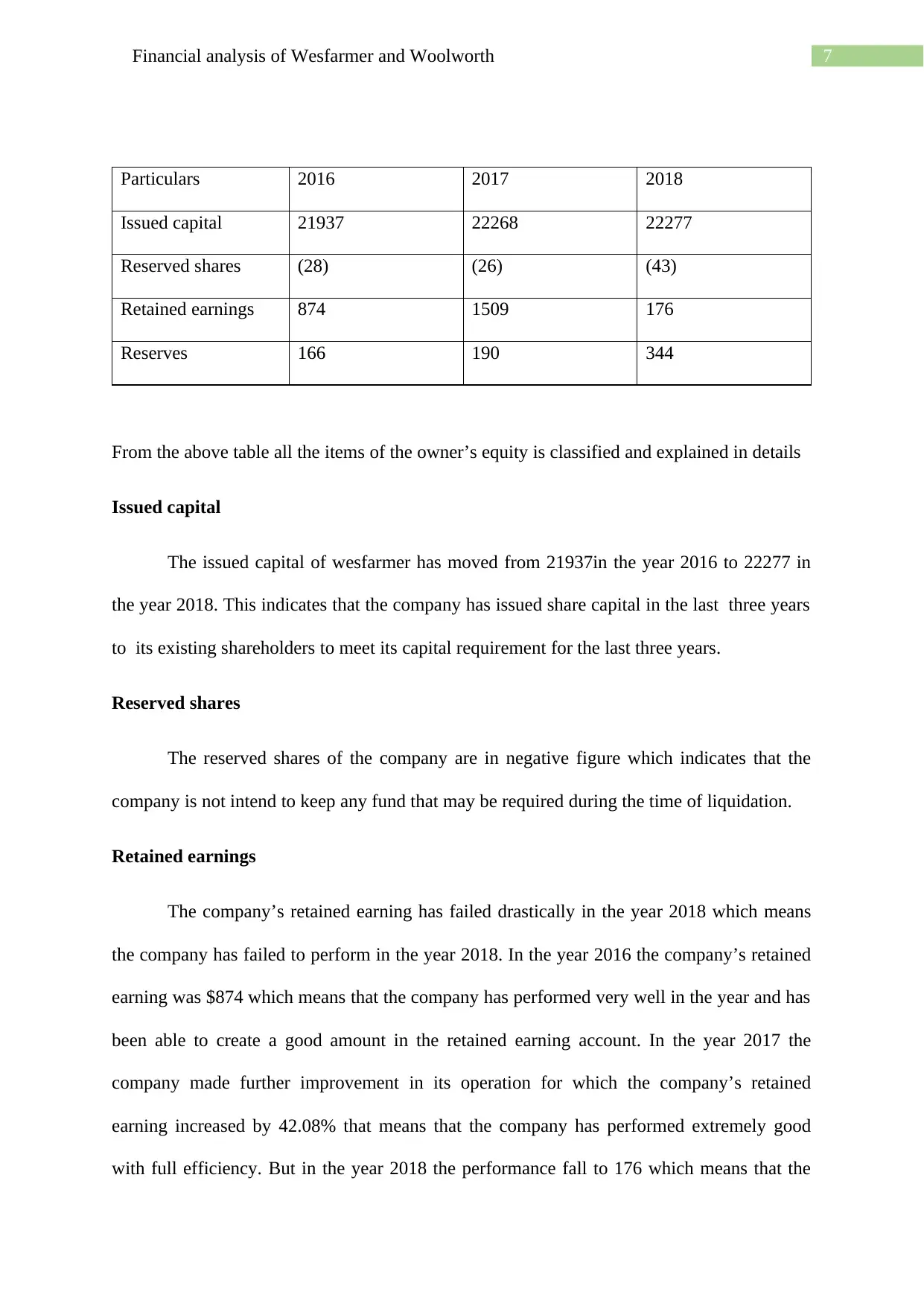
7Financial analysis of Wesfarmer and Woolworth
Particulars 2016 2017 2018
Issued capital 21937 22268 22277
Reserved shares (28) (26) (43)
Retained earnings 874 1509 176
Reserves 166 190 344
From the above table all the items of the owner’s equity is classified and explained in details
Issued capital
The issued capital of wesfarmer has moved from 21937in the year 2016 to 22277 in
the year 2018. This indicates that the company has issued share capital in the last three years
to its existing shareholders to meet its capital requirement for the last three years.
Reserved shares
The reserved shares of the company are in negative figure which indicates that the
company is not intend to keep any fund that may be required during the time of liquidation.
Retained earnings
The company’s retained earning has failed drastically in the year 2018 which means
the company has failed to perform in the year 2018. In the year 2016 the company’s retained
earning was $874 which means that the company has performed very well in the year and has
been able to create a good amount in the retained earning account. In the year 2017 the
company made further improvement in its operation for which the company’s retained
earning increased by 42.08% that means that the company has performed extremely good
with full efficiency. But in the year 2018 the performance fall to 176 which means that the
Particulars 2016 2017 2018
Issued capital 21937 22268 22277
Reserved shares (28) (26) (43)
Retained earnings 874 1509 176
Reserves 166 190 344
From the above table all the items of the owner’s equity is classified and explained in details
Issued capital
The issued capital of wesfarmer has moved from 21937in the year 2016 to 22277 in
the year 2018. This indicates that the company has issued share capital in the last three years
to its existing shareholders to meet its capital requirement for the last three years.
Reserved shares
The reserved shares of the company are in negative figure which indicates that the
company is not intend to keep any fund that may be required during the time of liquidation.
Retained earnings
The company’s retained earning has failed drastically in the year 2018 which means
the company has failed to perform in the year 2018. In the year 2016 the company’s retained
earning was $874 which means that the company has performed very well in the year and has
been able to create a good amount in the retained earning account. In the year 2017 the
company made further improvement in its operation for which the company’s retained
earning increased by 42.08% that means that the company has performed extremely good
with full efficiency. But in the year 2018 the performance fall to 176 which means that the
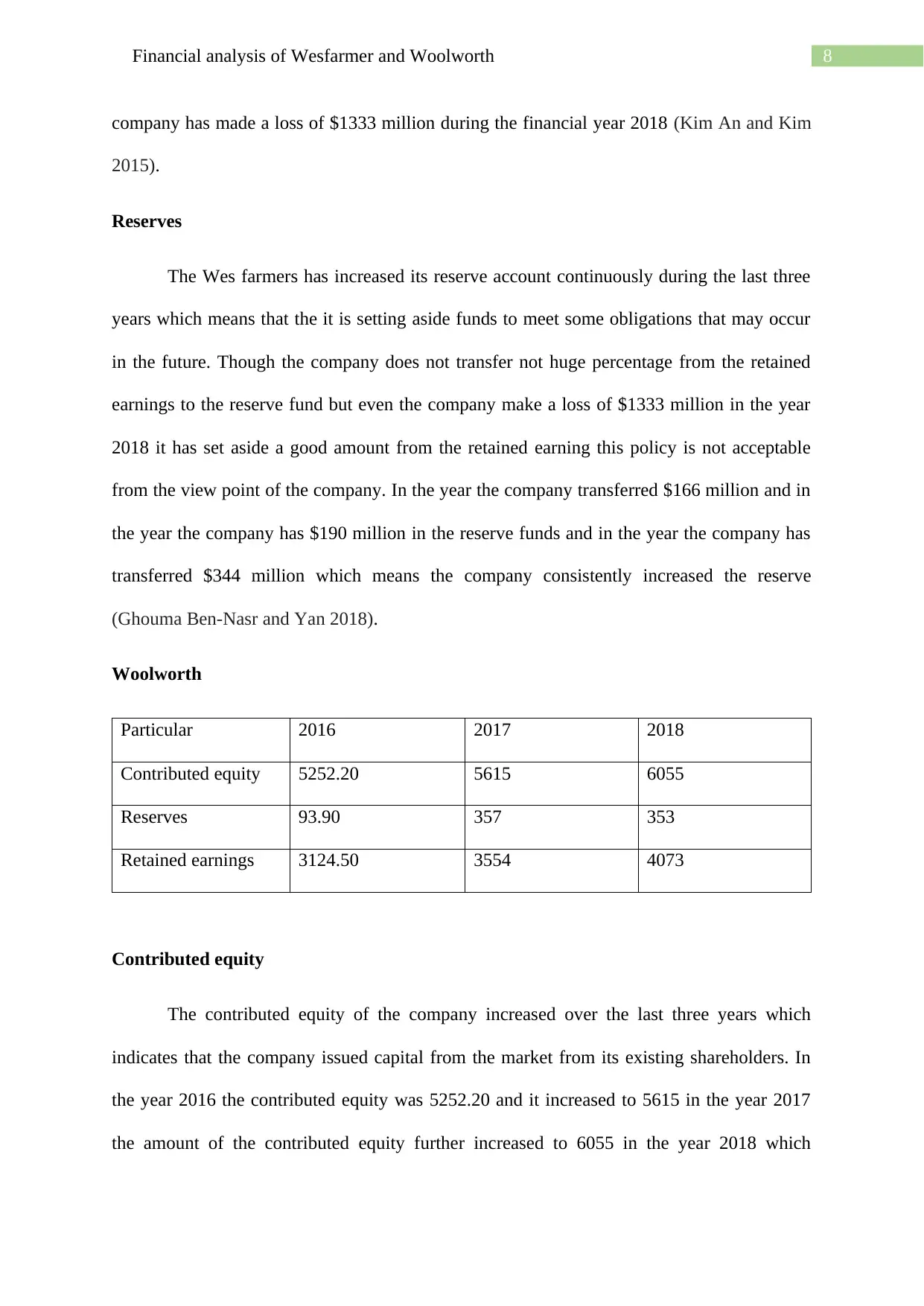
8Financial analysis of Wesfarmer and Woolworth
company has made a loss of $1333 million during the financial year 2018 (Kim An and Kim
2015).
Reserves
The Wes farmers has increased its reserve account continuously during the last three
years which means that the it is setting aside funds to meet some obligations that may occur
in the future. Though the company does not transfer not huge percentage from the retained
earnings to the reserve fund but even the company make a loss of $1333 million in the year
2018 it has set aside a good amount from the retained earning this policy is not acceptable
from the view point of the company. In the year the company transferred $166 million and in
the year the company has $190 million in the reserve funds and in the year the company has
transferred $344 million which means the company consistently increased the reserve
(Ghouma Ben-Nasr and Yan 2018).
Woolworth
Particular 2016 2017 2018
Contributed equity 5252.20 5615 6055
Reserves 93.90 357 353
Retained earnings 3124.50 3554 4073
Contributed equity
The contributed equity of the company increased over the last three years which
indicates that the company issued capital from the market from its existing shareholders. In
the year 2016 the contributed equity was 5252.20 and it increased to 5615 in the year 2017
the amount of the contributed equity further increased to 6055 in the year 2018 which
company has made a loss of $1333 million during the financial year 2018 (Kim An and Kim
2015).
Reserves
The Wes farmers has increased its reserve account continuously during the last three
years which means that the it is setting aside funds to meet some obligations that may occur
in the future. Though the company does not transfer not huge percentage from the retained
earnings to the reserve fund but even the company make a loss of $1333 million in the year
2018 it has set aside a good amount from the retained earning this policy is not acceptable
from the view point of the company. In the year the company transferred $166 million and in
the year the company has $190 million in the reserve funds and in the year the company has
transferred $344 million which means the company consistently increased the reserve
(Ghouma Ben-Nasr and Yan 2018).
Woolworth
Particular 2016 2017 2018
Contributed equity 5252.20 5615 6055
Reserves 93.90 357 353
Retained earnings 3124.50 3554 4073
Contributed equity
The contributed equity of the company increased over the last three years which
indicates that the company issued capital from the market from its existing shareholders. In
the year 2016 the contributed equity was 5252.20 and it increased to 5615 in the year 2017
the amount of the contributed equity further increased to 6055 in the year 2018 which
⊘ This is a preview!⊘
Do you want full access?
Subscribe today to unlock all pages.

Trusted by 1+ million students worldwide
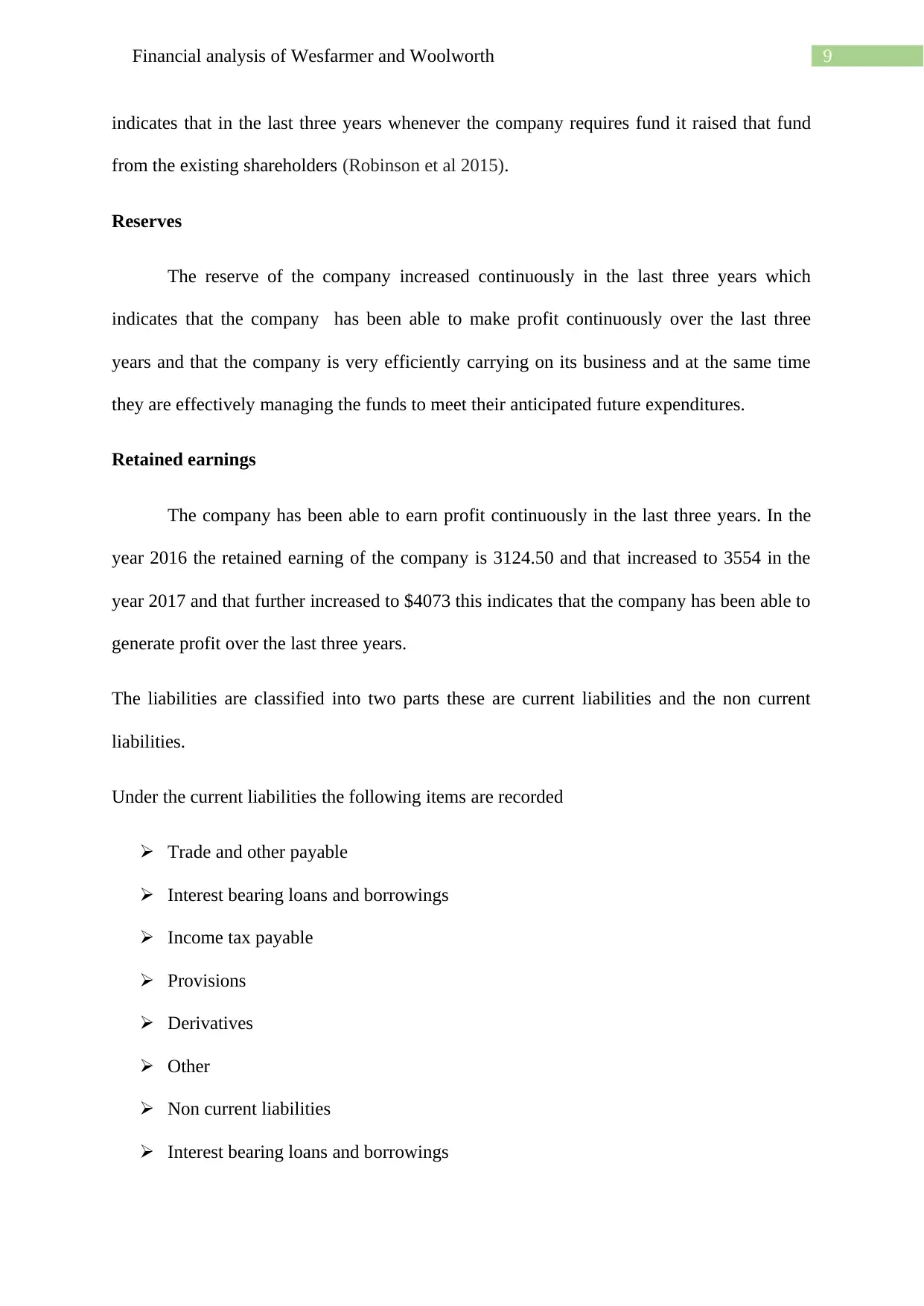
9Financial analysis of Wesfarmer and Woolworth
indicates that in the last three years whenever the company requires fund it raised that fund
from the existing shareholders (Robinson et al 2015).
Reserves
The reserve of the company increased continuously in the last three years which
indicates that the company has been able to make profit continuously over the last three
years and that the company is very efficiently carrying on its business and at the same time
they are effectively managing the funds to meet their anticipated future expenditures.
Retained earnings
The company has been able to earn profit continuously in the last three years. In the
year 2016 the retained earning of the company is 3124.50 and that increased to 3554 in the
year 2017 and that further increased to $4073 this indicates that the company has been able to
generate profit over the last three years.
The liabilities are classified into two parts these are current liabilities and the non current
liabilities.
Under the current liabilities the following items are recorded
Trade and other payable
Interest bearing loans and borrowings
Income tax payable
Provisions
Derivatives
Other
Non current liabilities
Interest bearing loans and borrowings
indicates that in the last three years whenever the company requires fund it raised that fund
from the existing shareholders (Robinson et al 2015).
Reserves
The reserve of the company increased continuously in the last three years which
indicates that the company has been able to make profit continuously over the last three
years and that the company is very efficiently carrying on its business and at the same time
they are effectively managing the funds to meet their anticipated future expenditures.
Retained earnings
The company has been able to earn profit continuously in the last three years. In the
year 2016 the retained earning of the company is 3124.50 and that increased to 3554 in the
year 2017 and that further increased to $4073 this indicates that the company has been able to
generate profit over the last three years.
The liabilities are classified into two parts these are current liabilities and the non current
liabilities.
Under the current liabilities the following items are recorded
Trade and other payable
Interest bearing loans and borrowings
Income tax payable
Provisions
Derivatives
Other
Non current liabilities
Interest bearing loans and borrowings
Paraphrase This Document
Need a fresh take? Get an instant paraphrase of this document with our AI Paraphraser
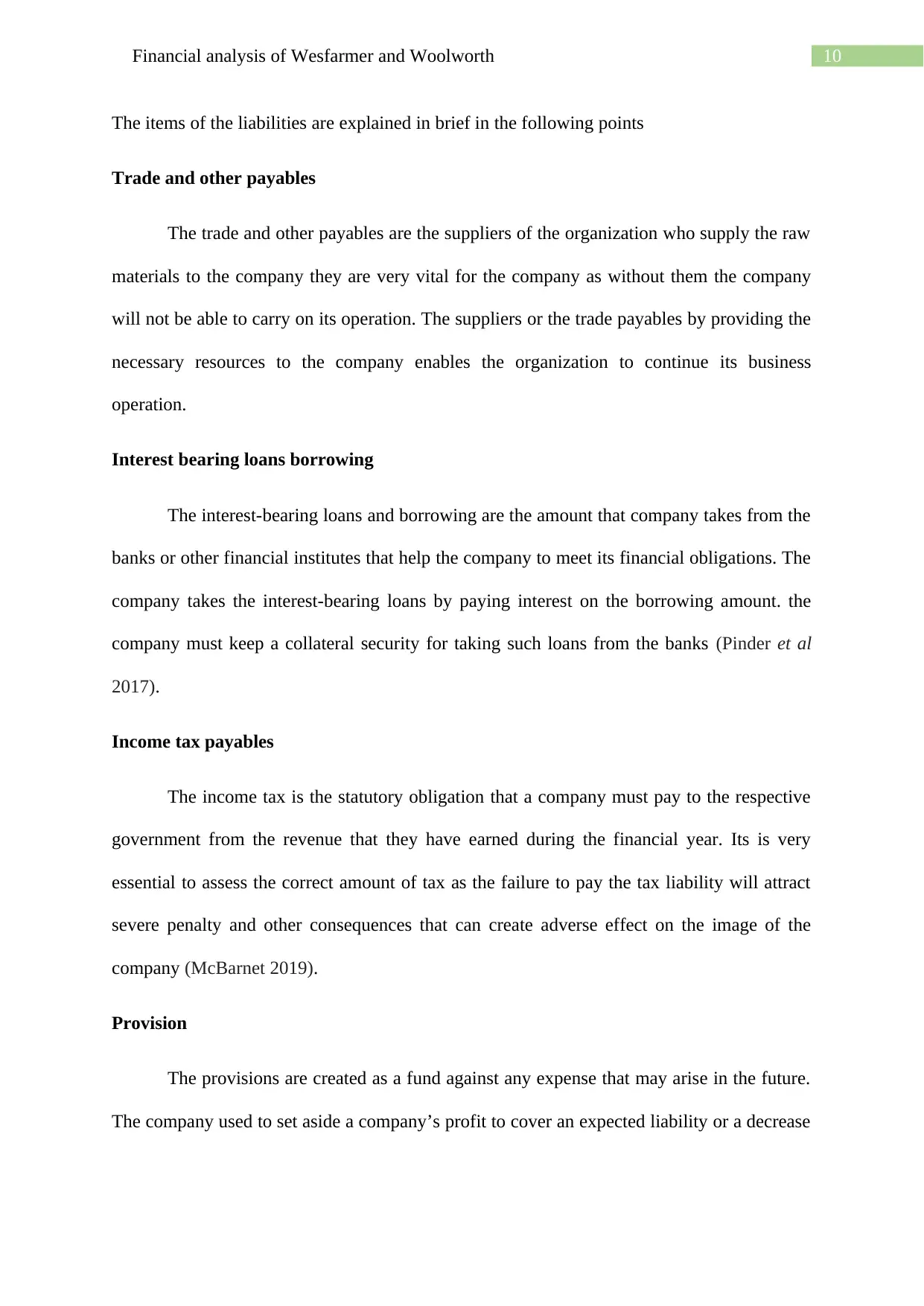
10Financial analysis of Wesfarmer and Woolworth
The items of the liabilities are explained in brief in the following points
Trade and other payables
The trade and other payables are the suppliers of the organization who supply the raw
materials to the company they are very vital for the company as without them the company
will not be able to carry on its operation. The suppliers or the trade payables by providing the
necessary resources to the company enables the organization to continue its business
operation.
Interest bearing loans borrowing
The interest-bearing loans and borrowing are the amount that company takes from the
banks or other financial institutes that help the company to meet its financial obligations. The
company takes the interest-bearing loans by paying interest on the borrowing amount. the
company must keep a collateral security for taking such loans from the banks (Pinder et al
2017).
Income tax payables
The income tax is the statutory obligation that a company must pay to the respective
government from the revenue that they have earned during the financial year. Its is very
essential to assess the correct amount of tax as the failure to pay the tax liability will attract
severe penalty and other consequences that can create adverse effect on the image of the
company (McBarnet 2019).
Provision
The provisions are created as a fund against any expense that may arise in the future.
The company used to set aside a company’s profit to cover an expected liability or a decrease
The items of the liabilities are explained in brief in the following points
Trade and other payables
The trade and other payables are the suppliers of the organization who supply the raw
materials to the company they are very vital for the company as without them the company
will not be able to carry on its operation. The suppliers or the trade payables by providing the
necessary resources to the company enables the organization to continue its business
operation.
Interest bearing loans borrowing
The interest-bearing loans and borrowing are the amount that company takes from the
banks or other financial institutes that help the company to meet its financial obligations. The
company takes the interest-bearing loans by paying interest on the borrowing amount. the
company must keep a collateral security for taking such loans from the banks (Pinder et al
2017).
Income tax payables
The income tax is the statutory obligation that a company must pay to the respective
government from the revenue that they have earned during the financial year. Its is very
essential to assess the correct amount of tax as the failure to pay the tax liability will attract
severe penalty and other consequences that can create adverse effect on the image of the
company (McBarnet 2019).
Provision
The provisions are created as a fund against any expense that may arise in the future.
The company used to set aside a company’s profit to cover an expected liability or a decrease
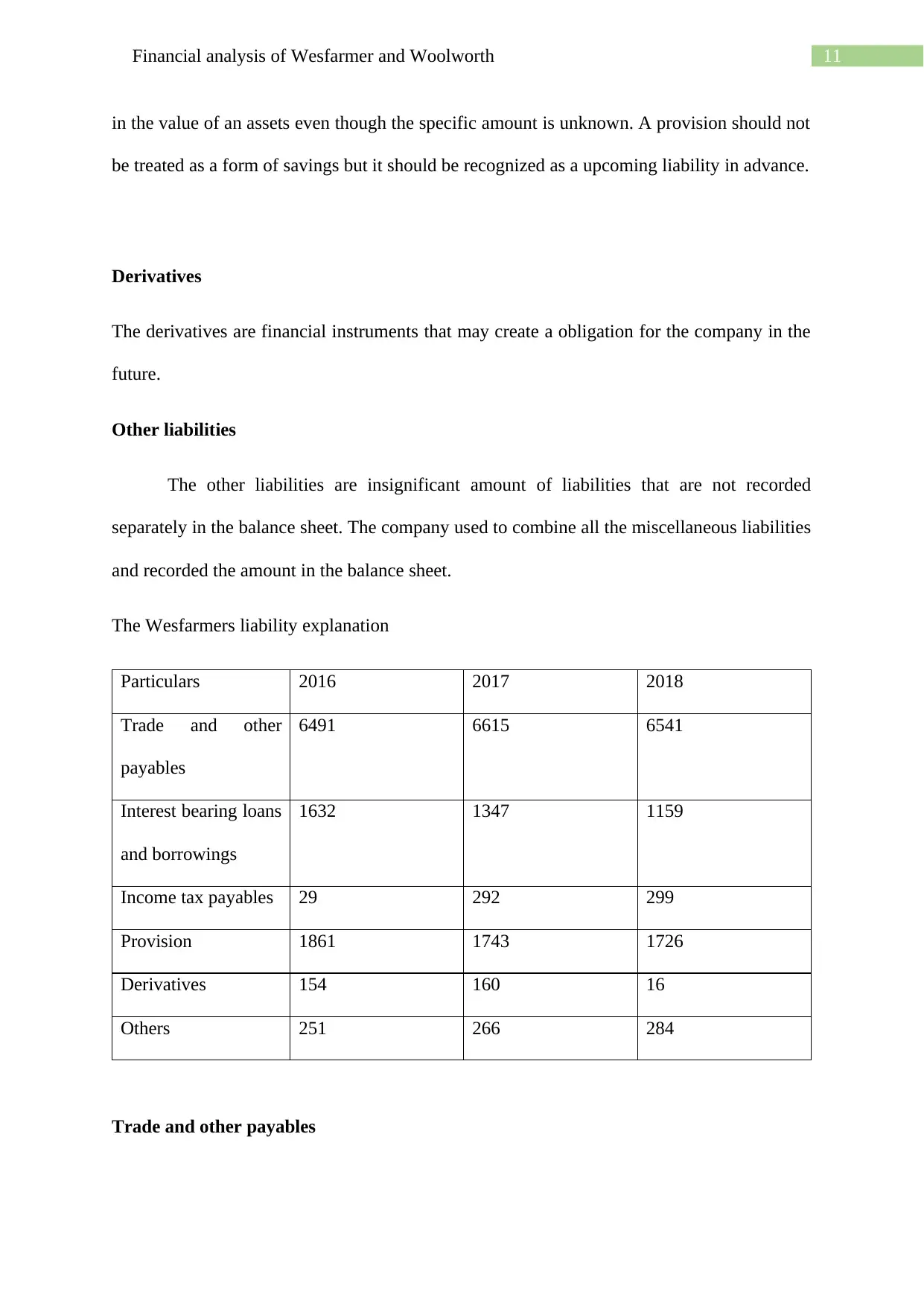
11Financial analysis of Wesfarmer and Woolworth
in the value of an assets even though the specific amount is unknown. A provision should not
be treated as a form of savings but it should be recognized as a upcoming liability in advance.
Derivatives
The derivatives are financial instruments that may create a obligation for the company in the
future.
Other liabilities
The other liabilities are insignificant amount of liabilities that are not recorded
separately in the balance sheet. The company used to combine all the miscellaneous liabilities
and recorded the amount in the balance sheet.
The Wesfarmers liability explanation
Particulars 2016 2017 2018
Trade and other
payables
6491 6615 6541
Interest bearing loans
and borrowings
1632 1347 1159
Income tax payables 29 292 299
Provision 1861 1743 1726
Derivatives 154 160 16
Others 251 266 284
Trade and other payables
in the value of an assets even though the specific amount is unknown. A provision should not
be treated as a form of savings but it should be recognized as a upcoming liability in advance.
Derivatives
The derivatives are financial instruments that may create a obligation for the company in the
future.
Other liabilities
The other liabilities are insignificant amount of liabilities that are not recorded
separately in the balance sheet. The company used to combine all the miscellaneous liabilities
and recorded the amount in the balance sheet.
The Wesfarmers liability explanation
Particulars 2016 2017 2018
Trade and other
payables
6491 6615 6541
Interest bearing loans
and borrowings
1632 1347 1159
Income tax payables 29 292 299
Provision 1861 1743 1726
Derivatives 154 160 16
Others 251 266 284
Trade and other payables
⊘ This is a preview!⊘
Do you want full access?
Subscribe today to unlock all pages.

Trusted by 1+ million students worldwide
1 out of 21
Related Documents
Your All-in-One AI-Powered Toolkit for Academic Success.
+13062052269
info@desklib.com
Available 24*7 on WhatsApp / Email
![[object Object]](/_next/static/media/star-bottom.7253800d.svg)
Unlock your academic potential
Copyright © 2020–2025 A2Z Services. All Rights Reserved. Developed and managed by ZUCOL.





